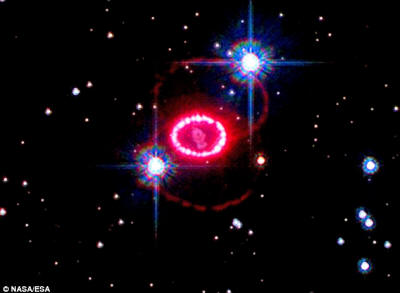|

by Daily Mail Reporter
9 August 2011
from
DailyMail Website
Planets can be ejected when a star dies during a supernova and be
left to roam the galaxy, according to a new study.
Experts led by astronomer Dimitri Veras at the University of
Cambridge found planets can survive the blast when a star dies.
Depending on the size of the star, the effect of the supernova will
change a planet's orbit and fling it out into space where it will
float, permanently unattached to any star.

An image of the
supernova remnant 1987A,
taken by the Hubble Space Telescope.
Scientists believe
planets can be ejected when a star dies
during a supernova and be
left to roam the galaxy
The theory is one explanation for the
clutches of 'free' planets discovered so far and could mean many
clusters exist across the Milky Way, according to National
Geographic.
In rare cases, the planets that survive the blast can also remain
tied to the remains of the star and find new orbits around what is
left behind.
Supernova is the word given to describe a star exploding, during
which its luminosity dramatically increases and most of its mass is
blown away at high speed.
Researchers came up with a new theory based on what is known in
physics as the 'two-body problem', which means two interacting
bodies such as a planet and star.
Orbits can be charted using simple equations using the two objects'
masses, positions and velocities but the new chart spotted a kink in
the approach. Because stars lose mass when they go into supernova
and die, the gravitational pull on planets in their orbit will
change.
Dr Veras said this change meant the researchers had to use computers
to simulate their orbits instead based on a new model.
The model indicated that inner planets orbiting several times the
distance between Earth and the sun are destroyed when stars at least
seven to ten times the mass of our sun explode.
However, planets orbiting 100 times the distance between Earth and
the sun will be thrown into interstellar space as their orbits are
altered by the blast.
The planets could end up in more distant orbits around what remains
of the star but any survivors would be empty, dead worlds.
'The observational evidence suggests
that there could be
more planets floating in between
stars than orbiting them'
They could also easily be picked up by
the gravitational pull of other nearby stars because they are no
longer locked into a strong orbit elsewhere.
Dr Veras said:
'Because every star dies, and many
of these stars are massive enough to trigger planetary ejection,
there is ample opportunity throughout the galaxy for stellar
deaths to contribute to the free-floating population.
'We don't know yet how common these
planets are, but the observational evidence suggests that there
could be more planets floating in between stars than orbiting
them.'
Steinn Sigurdsson, an astronomer at
Pennsylvania State University, suggested the 'free' planets could
also be down to larger planets knocking smaller ones out of their
position.
But he conceded it is possible the two effects could work together
with larger planets scattering the smaller ones more widely and the
supernova then throwing them out.
Experts believe life could still exist on a planet ejected in this
way as long as it still had enough heat and already supported
'sub-surface life'.
The chances of locating planets around a dying star which is about
to explode are minimal because of current technology and the
timescale, making it almost impossible to see the process in action.
Dr Veras said:
'All the ingredients are there.
However, the time scale to actually observe a planet being
ejected, in most cases, is longer than a human lifetime.'
|

